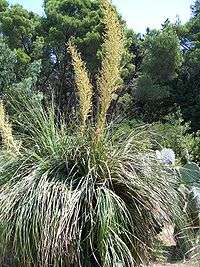Lokrum
Coordinates: 42°38′N 18°07′E / 42.633°N 18.117°E


Lokrum (pronounced [lɔ̌krum], Italian: Lacroma) is an island in the Adriatic Sea 600 metres (1,969 feet) from the city of Dubrovnik, Croatia. It stretches from northwest to southeast and receives regular ferry service from the city.
Austrian archduke (and short-lived Emperor of Mexico) Maximilian once had a holiday home on the island. A monastery and a botanical garden survive from his era. On the island's highest point at 96 metres (315 feet) above sea level stands Fort Royal Castle, which was built by the French, though it was later named "Maximilian's Tower" by the Austrians.
History
.jpg)
The first written mention of Lokrum was in 1023 when the Benedictine abbey and monastery were founded. The name Lokrum comes from the Latin, 'acrumen', meaning sour fruit. This derives from the tradition of cultivating exotic plants on the island, a tradition started in the time of the Benedictines. The last Benedictines left the island in 1808. Local legend says that on their last night, the monks put a curse on the island and anyone who tried to seek it for their own in the future.
According to legend, Richard the Lionheart was shipwrecked in 1192 after returning home from the crusades and was cast safely ashore on Lokrum. He pledged to build a church on the island but, at the plea of Dubrovnik citizens, the church was built on the nearby mainland instead.
Archduke Maximilian Ferdinand of Habsburg had a mansion built on the island in 1859 with a magnificent garden laid out, criss-crossed with pathways, full of amazing plants and botanical wonders. The island was originally purchased by Maximilian's wife Archduchess Charlotte of Austria, with part of her marriage dowry, and she retained ownership of the island even after she and her husband became Emperor and Empress of Mexico. After the Emperor Maximilian's execution the island was surrendered to the Habsburg Family in a deal struck between Franz Joseph I of Austria and Leopold II of Belgium. Charlotte had become insane and Leopold had renounced in the name of his sister all claims to her and her husband's property in Austria. Leopold was more concerned with acquiring his sister's great fortune than with her rights to property in Austria. The island was given to Archduchess Elisabeth Marie of Austria as part of her marriage dowry; Yugoslavia claimed it under the Treaty of Saint-Germain. Princess Elizabeth stated that she was no longer a Habsburg, having renounced her rights on the occasion of her marriage; therefore Yugoslavia had no right to sequester the property. The case was settled by a payment of $575,000 to the Princess.
In 1959 a Botanical Garden was founded on Lokrum which contains native and imported, tropical and subtropical plants, and other vegetation originating from Australia and South America. The island is also inhabited by families of peacocks brought over by Maximilian from the Canary Islands.
The island is now a popular destination with visitors to Dubrovnik. A restaurant is located in the former monastery, and walking routes round the island are marked out. There is also a nudist beach at the south-eastern end of the island.
Botanical Garden
On the eastern side of the island, protected from the open sea, there is a small natural harbour. The island covers an area of 0.8 square kilometres (0.31 sq mi) and is covered in thick Mediterranean flora and woods: laurel, oak, pines, cypress and black pines. There are also olives, agaves, cacti, magnolia and palms. On the southern part of the island there is a small salt lake, 10 m deep, known as "the Dead Sea" (Mrtvo More). Nearby there is a deserted Benedictine monastery, founded in 1023. The triple-naved basilica, and a 14th-century part of the monastery were badly damaged in the 1667 earthquake.[1] The monastery was deserted in 1798. Today Lokrum is a Nature Reserve and a Special Forest Vegetation Reserve.
Gallery
 Path to the botanical garden
Path to the botanical garden- View of the botanical garden


See also
References
- ↑ Naklada Naprijed, The Croatian Adriatic Tourist Guide, pg. 364, Zagreb (1999), ISBN 953-178-097-8
External links
| Wikimedia Commons has media related to Lokrum. |
- Botanical Garden on the Island of Lokrum
- Island of Lokrum, An Island of Legend and Authenticity
- The Legend of the Lokrum Curse